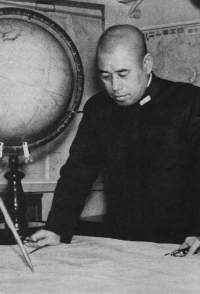


Jonathan Parshall:
Mastermind of the Pearl Harbor attack, and leader of Combined Fleet until 1943, his plane was shot down over Bougainville on April 18, 1943 by American P-38 aircraft. I personally think Yamamoto was a gifted individual, but also a bit over-rated. His needlessly complex operational scheme at the Battle of Midway dispersed his forces in the face of a still-dangerous foe, and directly led to the disaster there. Further, in the subsequent battles around the Solomons he was seemingly unable to capitalize on the weaknesses of the U.S. carrier forces opposing him, and was also unwilling (until it was too late) to risk sending the heavy surface units of the Combined Fleet down there to kick some butt. This unwillingness, to me, belies Yamamoto's underlying belief that battleships still were the ultimate arm of decision, and should therefore be hoarded in hopes of participating in a Decisive Battle.
C. Peter Chen:
Yamamoto was among the first Japanese officers to recognize aviation as the 'next big thing' in naval warfare; in fact, he played a role in the humble beginning of the Japanese Navy's air arm as the head of the Aeronautics Department and as commanding officer of the First Carrier Division. His concept of using air power to destroy the United States' ability to wage war in the Pacific Ocean was the foremost example of his faith in this relatively new technology. Ironically enough, his endless pursuit of a Mahanian decisive battle with the surface fleet was his ultimate short-coming. His early support of the Japanese naval air arm and the early successes in the Pacific War meant that he should be at least partially responsibility for Japan's inability to manufacture enough aircraft and train enough pilots to replace casualties.
Links From Related Partner Sites
WW2DB biography of Isoroku Yamamoto
See all photos of Isoroku Yamamoto on WW2DB

